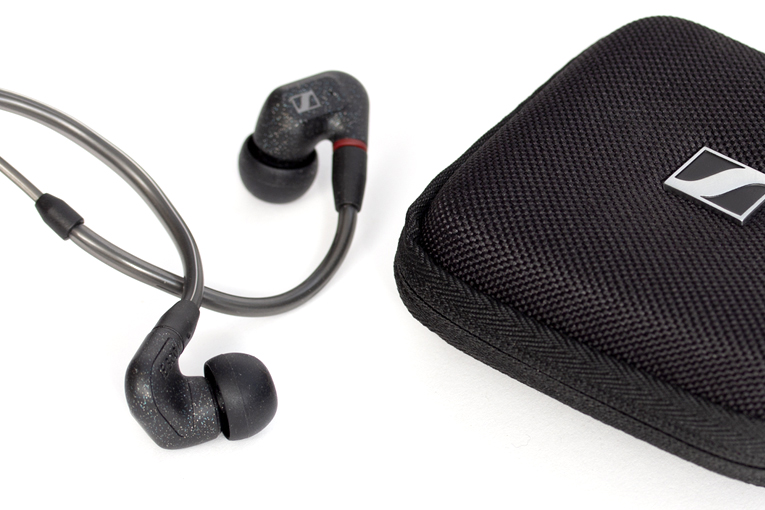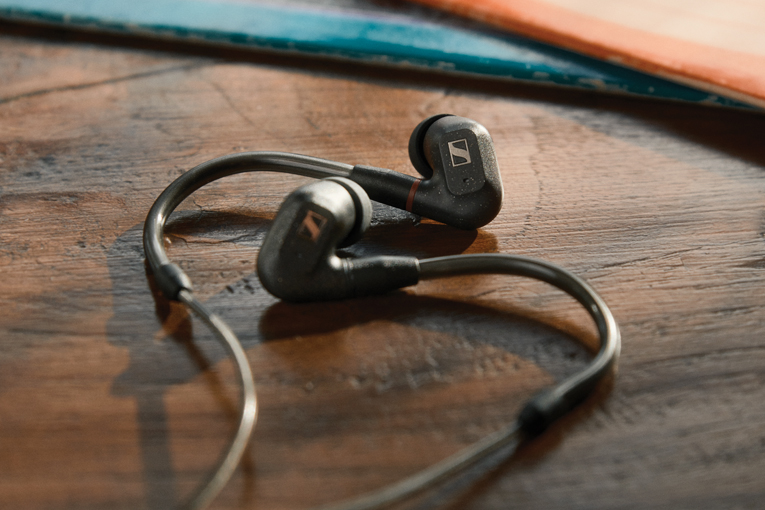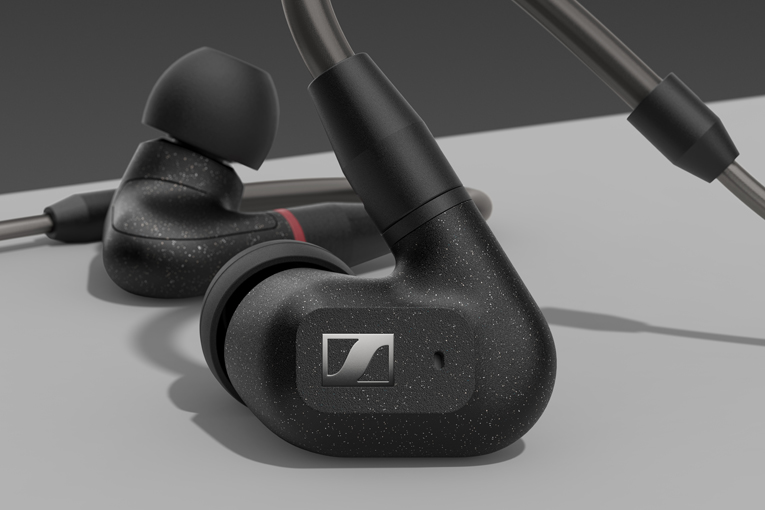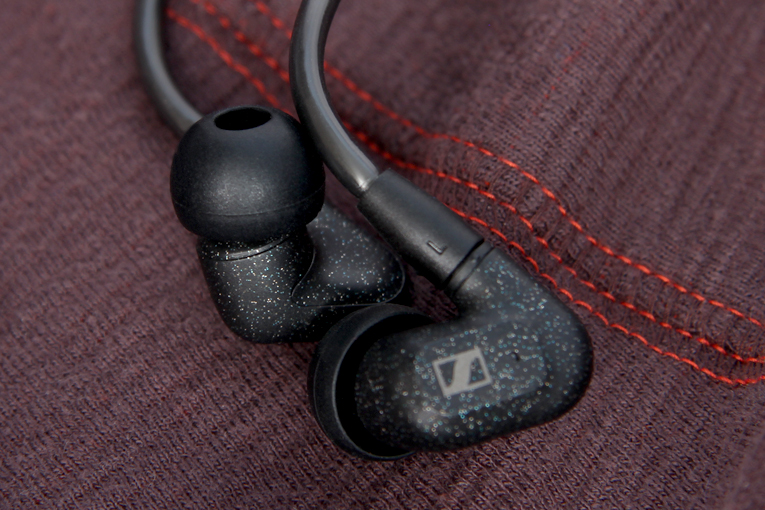Sound: 









Value: 









(Read about our ratings)
Measurements can be found by clicking this link.
One thing I love about earphones is that you can get state-of-the-art sound in lots of different ways. You can pack an earphone with multiple drivers and a crossover. You can explore exotic driver designs. Or you can tune a basic dynamic driver to near perfection. With the IE 300s ($299, all prices USD), Sennheiser takes the third—and, I think, riskiest—path.
If the IE 300s didn’t have a Sennheiser logo on the side of each earpiece, I’d guess they came from one of the Chinese brands that sell audiophile-style designs for prices in the mid-double digits. They’re as unflashy as they could be, with a matte charcoal finish; thin, gray cables; and a generic molded plug. I can’t imagine it’s easy to sell generic-looking earphones with a single dynamic driver in each earpiece for $300. But according to Sennheiser’s website, the IE 300s “got it where it counts”—in a 7mm, foil-diaphragm dynamic driver, backed by a tuned chamber with a tiny vent in the rear.

The IE 300s use the over-the-ear cable routing commonly found in audiophile-oriented earphones. I think that’s generally a good thing because it makes them less likely to be accidentally pulled out, and if designed properly, it allows a deep fit into the ear with excellent isolation from outside sounds.
The rated impedance is 16 ohms, and rated sensitivity is sky-high at 124dB—but that’s at 1kHz (instead of the IEC 60268-7 standard of 500Hz) and at 1V RMS. That’s a 62.5mW signal into 16 ohms; headphone/earphone sensitivity is normally measured with a 1mW signal. By my calculations, the IE 300s’ rated sensitivity at 1mW would be about 106dB, but we’ll see what the measurements say.
In the box
The package includes the earphones, a semi-hardshell case, and a 49ʺ (1.26m) cable with MMCX connectors on the earphone ends and a 3.5mm (1/8ʺ) unbalanced stereo plug on the other. Sennheiser includes three sizes of foam tips and three sizes of silicone tips, and there’s also a cleaning tool in the box.
Use
Unlike many bulky earphones with over-the-ear cable routing, the Sennheisers fit easily into my ears, and the bendable ear hooks at the top made it easy to curve the cables to fit my ears. None of the stock tips were quite big enough to get a good seal in my roughly 10% oversize ear canals (although the biggest silicone tips were close), but I was able to get a good fit using Periodic Audio Hydrogen single-flange silicone tips. Fortunately, the soundtubes on the IE 300s measure about 5mm, so it’s easy to find aftermarket tips that fit them.

The skinny cable is so 2010 in that it can tangle easily, but it’s far from being the most tangle-prone cable I’ve encountered. And it made me appreciate the unheralded improvements headphone manufacturers have made in their cables.
My Samsung Galaxy S10 smartphone could easily drive the IE 300s to loud levels. Regardless, I did most of my listening using an AudioQuest DragonFly Cobalt DAC-headphone amp, just to ensure I’d get the best from these earphones.
Sound
It took a little while for me to find tips that fit me right, and to get used to bending the cables into place over my ears. But once I got the IE 300s dialed in, I could tell right away that they’re pretty good. They had some subtle anomalies in their response, but they seemed to be the kind of charming and harmless traits that can give an audio product a little bit of character without marring the sound of the music.
Baritone saxophonist Nick Brignola’s 2002 album Tour de Force (16-bit/44.1kHz FLAC, Reservoir Music / Qobuz) is great from a musical standpoint, but also in the challenges it presents for audio reproduction. It has a rather dark sound—guitarist Chuck D’Aloia’s sound has the super-rolled-off character associated with Pat Metheny, and double bassist Eddie Gomez’s axe sounds soft except when he’s soloing. A good set of headphones or earphones will pull the subtle twang from Tour de Force’s guitar and the mostly buried definition in its low bass notes, and the IE 300s accomplished just that—apparently without “cheating” by accentuating certain bands of audio. I’ve been listening to this album a lot lately, and the IE 300s, plugged straight into my phone, gave me more subtleties and detail than I got from most of the other audio systems I’ve listened to it on.

As I alluded to before, I could tell there was a little bit of an upper-midrange coloration in the IE 300s somewhere, and the easiest way to sort that out is usually with female vocals. On jazz singer Susie Arioli’s version of “Here’s That Rainy Day” (All the Way, 16/44.1 FLAC, Jazzheads/Qobuz), I was struck by the natural sense of space the IE 300s conjured; it felt almost as if I were listening to open-back planar-magnetic headphones. The spatial contrast between the electric guitar and the vibes was a little bit breathtaking, with the former fairly soaked in reverb and the latter sounding like it was about six feet in front of me. But the pristine recording of Arioli’s smooth, warm-sounding voice let me find that little coloration—it sounded like a little extra peak somewhere in the 3 to 5kHz range. This is pretty common in earphones, and it’s a more subtle peak than I’m used to hearing with similar products, but it did give Arioli’s voice a little bit of extra buzz in the upper harmonics—although maybe it also contributed to that sense of space I heard.
I was slightly shocked when I put on “Redemption” by roots-R&B-rock singer/songwriter Nathaniel Rateliff (single, from the Apple TV movie Palmer, 24/48 FLAC, Stax/Qobuz). I heard such a strong center image in the intro that I thought for a second that maybe the DragonFly Cobalt had gotten unplugged from my phone, and I was hearing the phone’s speaker. As the tune continued, I enjoyed the same huge sense of space I heard on the Susie Arioli recording, but I didn’t note the same vocal colorations. I assume Rateliff’s fairly deep voice doesn’t reach into the audio band affected by that little peak I heard (although the handclaps that come in for the bridge did seem a little bright). Best were the backing vocals that enter toward the end of the tune, which were either recorded in a huge space or bathed in reverb.

Comparing Wynton Marsalis’s first classical recordings, made in 1983, to 1994’s The London Concert (16/44.1 FLAC, Sony Classical / Qobuz) is a great way to test the tonal balance of audio products. The former—made using early-digital-era gear—should sound a little bright, and the latter should sound much smoother and less fatiguing. For example, in The London Concert version of the second movement, “Allegro moderato,” in Leopold Mozart’s Concerto for Trumpet and Orchestra in D Major, Marsalis’s trumpet sounds clear as a . . . bell! . . . without ever blaring, as even the most talented trumpeters sometimes do on recordings. Same for the string section and harpsichord of the English Chamber Orchestra—both sounded beautiful, detailed, and natural, even at loud volume. But in the original version, from Haydn, Hummel, L. Mozart Trumpet Concertos (16/44.1 FLAC, Sony Classical / Qobuz), the trumpet and strings practically screech your eardrums out at even moderately loud volumes. If the earlier version sounds good, your headphones probably sound too dull.
Comparison
I compared the IE 300s mostly to the JVC HA-FW01 earphones ($349), which are comparable in price and also use a single dynamic driver (albeit an 11mm one with about 2.5 times the surface area). I also compared them with the 1More Quad Drivers (originally $199.99, now selling for a bit more than half that on Amazon) and the Meze Rai Pentas ($1099), a high-end five-driver design.
“Free Man in Paris” from Joni Mitchell’s Court and Spark (24/192 FLAC, Rhino-Elektra/Qobuz) has lots of challenges for earphones: acoustic guitar, high-pitched flutes, and Mitchell’s wide vocal range. I could hear that little bit of extra brightness in the lower treble of the IE 300s, but I loved the clarity and found the sound generally well-balanced from bass to mids to treble.
The HA-FW01s had a fuller sound with more bass (which most listeners would probably prefer), but the midrange of Mitchell’s voice sounded subtly coarse in comparison, and the highs weren’t as delicate as with the IE 300s—pretty much what I’d expect given the earphones’ driver sizes. The Quad Drivers sounded coarser still in the mids—not what I’d call fatiguing, just not as clear and smooth as the others, and without the IE 300s’ high-frequency extension. The Rai Pentas had more definition and detail in the bass and the treble, although I have to say that the IE 300s sounded like they have a flatter overall frequency response.
Conclusion
I think the IE 300 earphones provide some of the best sound you can get for $300. That might seem like a lot to pay for a set of rather ordinary-looking single-driver earphones, but if sound quality matters more than bragging rights, these will float your boat.
. . . Brent Butterworth
Associated Equipment
- Smartphone: Samsung Galaxy S10
- DAC-headphone amp: AudioQuest DragonFly Cobalt
Sennheiser IE 300 Earphones
Price: $299 USD.
Warranty: Two years.
Sennheiser Electronic Corporation
1 Enterprise Drive
Old Lyme, CT 06371
Phone: (800) 736-6434
Website: www.sennheiser.com




